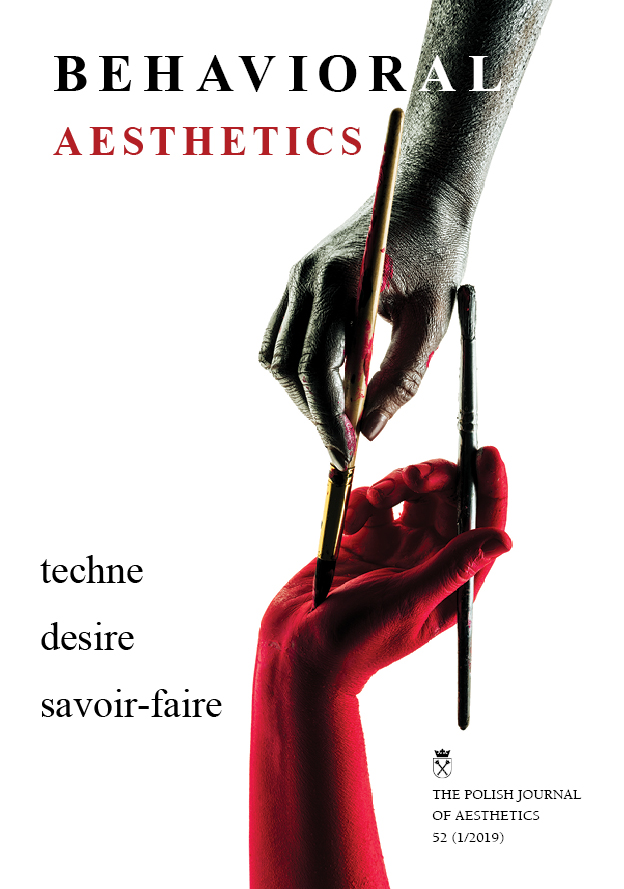Numer 52 (1/2019)
Behavioral Aesthetics. Techne, Desire, Savoir-Faire|
Spis treści
Strony
Pobierz
|
|||||
|
|
|||||
|
INFORMACJE O AUTORACH Daniel Ross Centre Georges Pompidou, Francja Adrian Mróz Uniwersytet Jagielloński w Krakowie |
|||||
|
|
|||||
|
INFORMACJE O AUTORZE
University of the Western Cape in South Africa
|
|||||
|
Daniel Ross
Mind Snatchers of the Anthropocene. Can Aspects Dawn within the Gulag Architectonic
DOI: 10.19205/52.19.1
21 – 40
|
|||||
|
Słowa kluczowe Edmund Husserl |Immanuel Kant |Ludwig Wittgenstein |Bernard Stiegler |Anthropocene |Algorithmic Governmentality |Peter SzendyStreszczenie It could be said that the real challenge of the Anthropocene is to confront the question of a converted gaze, in a way that requires and exceeds Kant’s notion of an extraterrestrial standpoint of standpoints. In a world where political points of view seem contained within impenetrable filter bubbles, how might Wittgenstein’s account of aspect-blindness with respect to bistable percepts point us to a new understanding of the loss of disparation caused by what Rouvroy and Berns call algorithmic governmentality? Husserl’s account of the melody as paradigmatic temporal object, which is fundamental to Stiegler’s account of the controllability of perception, desire and behaviour, could be revised in such a light, because the peculiar dimensionality of the visual image is still crucially at stake in any new geopolitics of the sensible to be found or invented in a world dominated by the ubiquitous digital screen. INFORMACJE O AUTORZE
Centre Georges Pompidou, Francja
|
|||||
|
Debora Pazetto Ferreira
Artificial Dreams: Contemporary Intersections between Art and Technology
DOI: 10.19205/52.19.2
41 – 55
|
|||||
|
Słowa kluczowe art |technology |Post-history |artificial intelligence |AuthorshipStreszczenie This paper approaches the intersectional field between art and technology from a Flusserian perspective applied to an interesting example: images generated through the program Google Deep Dream. These digital images that look like surrealist paintings are made through a distortion in Google’s artificial neural networks. I argue that these images problematize philosophical dualisms, like those between human intelligence and artificial intelligence, authorship and anonymity, individuality and collectivity, domination and deviation, art and technology. INFORMACJE O AUTORZE
Centro Federal de Educação Tecnológica de Minas Gerais, Brazylia
|
|||||
|
David Charles Wright-Carr
Embodied Cognitive Science, Aesthetics, and the Study of Visual Language
DOI: 10.19205/52.19.3
57 – 71
|
|||||
|
Słowa kluczowe cognition |embodiment |Aesthetic Experience |Visual LanguageStreszczenie The paradigm of embodied cognition provides a perspective for rethinking the nature of experience, intersubjectivity, and the interaction of the human animal with its physical and sociocultural environments. Embodied cognitive science can be a productive framework for the study of aesthetic experience and visual communication, enabling us to transcend the cognitivist paradigm of the twentieth century, understood here as the view that cognition is the rule-based manipulation of symbolic representations in a disembodied and decontextualized mind. Summaries of key concepts of embodied cognition are provided, with suggestions for their use in the exploration of aesthetics and visual language. INFORMACJE O AUTORZE
Universidad de Guanajuato, Meksyk
|
|||||
|
Francis Mechner
A Naturalistic and Behavioral Theory of Aesthetics
DOI: 10.19205/52.19.4
73 – 93
|
|||||
|
Słowa kluczowe Aesthetics Theory |Behavioral Aesthetics |Pavlovian Conditioning |Operant Behavior |Beauty in the ArtsStreszczenie Aesthetic reactions occur when cognitive and affective elements interact, in diverse arts. Affective elements result from past Pavlovian conditioning events and other sources. Compounding raises these effects to the level of aesthetic reactions. Properties of domains in which aesthetic reactions occur are identified. Cognitive ability is selected phylogenetically by the discernment of beauty. Aesthetic reactions help maintain competencies like language, conceptualization, and abstract thinking. INFORMACJE O AUTORZE
The Mechner Foundation, USA
Columbia University, USA |
|||||
|
|
|||||
|
Słowa kluczowe Transductive Relationships |Individuation |General Organology |Art and Behavior |new materialismStreszczenie This article presents a new approach to studying aesthetics by weaving together a thread of ideas based on investigating the problematics of the philosophy of art from a behavioral paradigm in order to exceed the margins of aesthetics. I claim that it makes no sense to ask if something is art, but rather we should be looking out into the manners in which art subsists, consists, and insists itself. Several notions of what I call behavioral aesthetics are proposed such as observation, aesthetic experience and aesthetic conditioning, behavioral materialism, out-comes, behavioral memory and replication or acquisition, interaction and intra-action, emotional engineering, artificial instincts, aesthetic dissonance, and the problem of measurement. The proposed goal of behavioral aesthetics consists in studying the process of individuation as constitutive of art with the methods of Bernard Stiegler’s general organology and genealogy of the sensible. The article presents a behavioral stance as a borderline mode for approaching the genealogy of aesthetics. I mostly refer to Tania Bruguera’s Behavior Art School and Wright Judson’s Behavioral Art, and the paradigm of new materialism, notably agential realism of Karan Barad. INFORMACJE O AUTORZE
Uniwersytet Jagielloński w Krakowie
|
|||||
|
|
|||||
|
INFORMACJE O AUTORZE
Muzeum Luwru, Francja
|
|||||
|
|
|||||
|
INFORMACJE O AUTORZE
Muzeum Luwru, Francja
|
|||||
|
|
|||||

